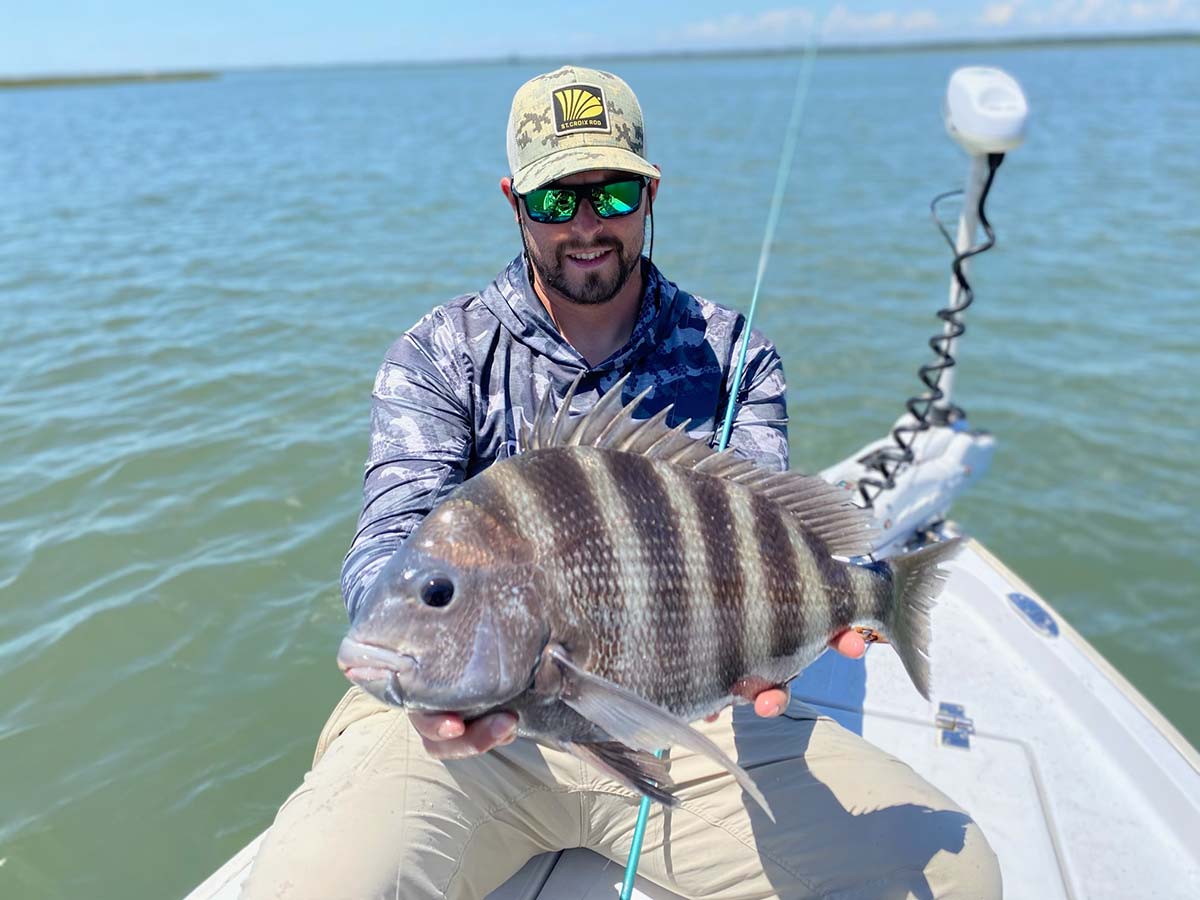
Well, the cat is out of the bag. Or more like the sheeps are out of the pen!
New Jersey is known for many great things including, tomatoes, WaWa with full-service gas, Taylor ham (or pork roll), legendary music, and highways with islands so large that people can get lost in them. But as of recently, the backwater bays in the Garden State have become known for one fish that has returned with a vengeance – the sheepshead.
Few fishermen target this elusive, exotic species, but it is quickly growing in popularity.
A Sheepish History
Everything about the sheepshead is an enigma. “What is in the name anyway,” Jim Hutchinson asked in the September, 2021 edition of The Fisherman (“NY/NJ Sheepshead: So What’s In A Name Anyway”). How did the sheepshead get its name? John Waldman, professor of biology and author of several famous fishing novels simply said, “No one seems to know.” Some postulate that the fish itself might bear some resemblance to a sheep’s silhouette. Others claim that it is from its teeth resembling a sheep! But either way, however it got its name, the sheepshead did play a role in the naming of the Sheepshead Bay section of Brooklyn, NY.
In the early 19th century, sheepshead were so plentiful in that bay that farmers would supplement their income by becoming commercial sheepshead fishermen on the side. But somewhere in the late 1800s, the sheepshead mysteriously vanished. Why? Well, we are back to the enigma. Again, no one really knows. Scientists point to the disappearance of oyster reefs from massive amounts of pollution at the time along with the massive overfishing occurring to be more than coincidental. These drastic changes certainly could have pushed fish down to sunny Florida where the water is clean and food is plentiful.
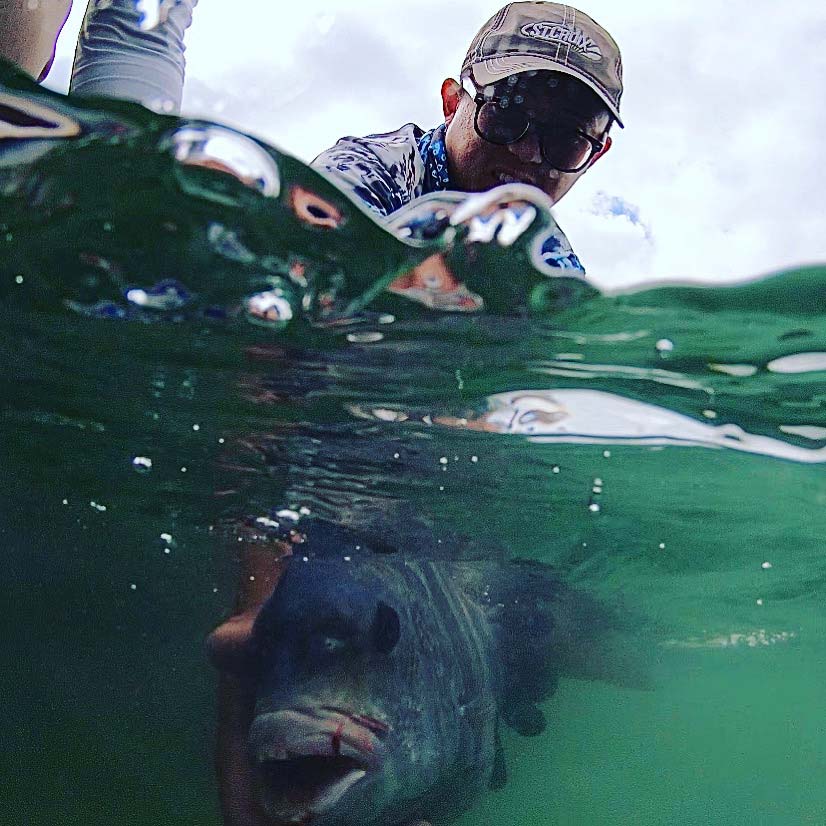
Yet, in the present day, sheepshead are beginning to return in great numbers and again we have no idea why. Should I mention the enigma again? We can always cite climate change being the reason. The warmer waters may have shifted the migration patterns, bringing sheeps back to the region. Or we could cite the stricter regulations, although still loose in most states like New Jersey, stabilizing the population.
But the more likely culprit comes from the “ReClam the Bay” initiative and others like it. The reintroduction of shellfish beds and the thriving oyster business in Barnegat Bay has led to a significant amount of food sources for sheeps while purifying the water. Add in some environmentally friendly laws to stop water pollution and we have created an ecosystem perfect for the sheepshead to return. Time will tell if this will be enough to return the sheepshead to their glory numbers many moons ago.
Migration Matters
What is even more fascinating about the return of sheepshead comes from a conversation with Lewis Naisbett-Jones from the UNC Institute of Marine Sciences, who satellite tags sheepshead in North Carolina to track the migration and movement of these fish. He noted:
“The sheepshead are a relatively understudied fish compared to many. While [NY and NJ] are certainly within the northern part of their range, we don’t really know much about the movements in these areas. What is interesting, and in my research, we don’t have any data suggesting that fish in North Carolina migrate great distances. On the contrary, what we’re seeing appears to be small-scale offshore movements during the winter and a high fidelity of fish to inshore areas during the summer.”
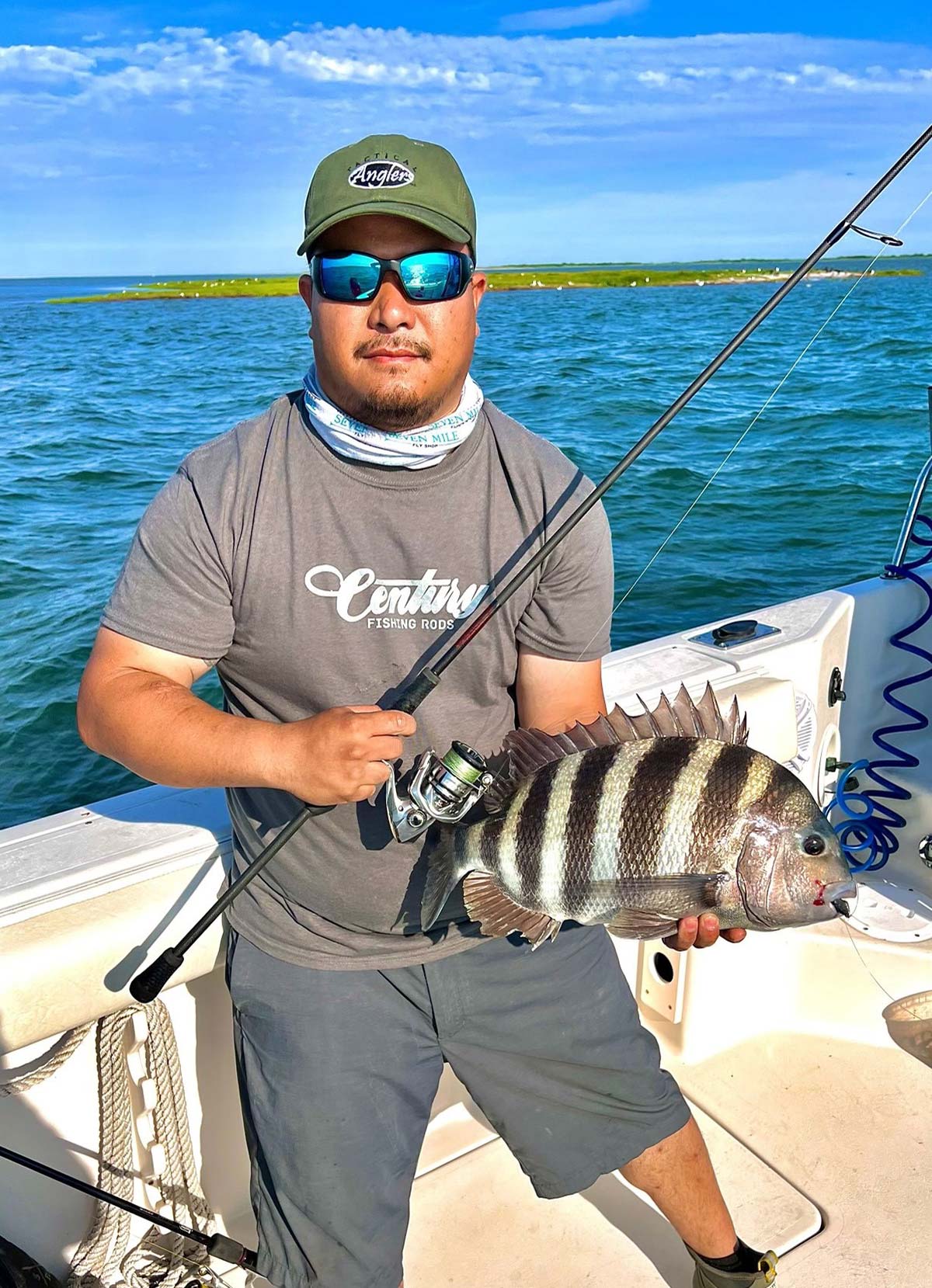
This means that North Carolina fish tagged at one particular bridge, migrate offshore for a short period of time, and miraculously seem to come back to the exact same spot they were tagged. So how and why sheepshead are coming to NJ is even more puzzling than ever! Are they breeding in our backwaters? Or do they migrate in and out with the drum as sheepshead guru Capt. Dan Shafer of Insomniac Guide Service and Bottom Sweeper Jigs would suggest?
Either way, more and more double-digit fish are caught each year with the average fish in New Jersey probably falling into the 7- or 8-pound range, shattering the 3- to 4-pound average down south. The current New Jersey record is a staggering 19 pounds, 3 ounces set in 2014, and just last year a new spearfishing record was set. So really the only clear thing about recent sheepshead history is that each summer bigger and larger fish return to the backwaters of New Jersey and Delaware Bay. But I don’t think anyone is complaining!
Finding A Jersey Unicorn
To be a successful sheepshead angler, you have to understand sheepshead biology. Of course, a blind squirrel can find a nut every once and a while but to consistently catch sheepshead there are two key aspects to understand: structure and feeding habits/tendencies.
But first, it is important to understand that sheepshead aren’t around year-round, just like migratory stripers. So, targeting sheepshead when there aren’t any around would just be a fool’s errand. The earliest we have caught sheepshead is the first week of May which coincides with when the black drum also start to invade the bay to spawn. The season runs between May and November; the rogue fish has been caught in December but this is extremely rare. The best months for catching sheepshead happens to be between August and September when the water just starts to cool.
If you want to find sheepshead, the best analogy is to think like a tautog/blackfish; sheepshead love structure. Rocky bottoms, jetties, wrecks, bridges, and piers are all sheepshead favorite hangouts because of the ample supply of barnacles and crabs for food. What’s interesting to note is that most sheepshead are caught inshore within 50 feet of water. For some reason, they stay out of the depths and tend to stay inshore in the inlets and back bay.
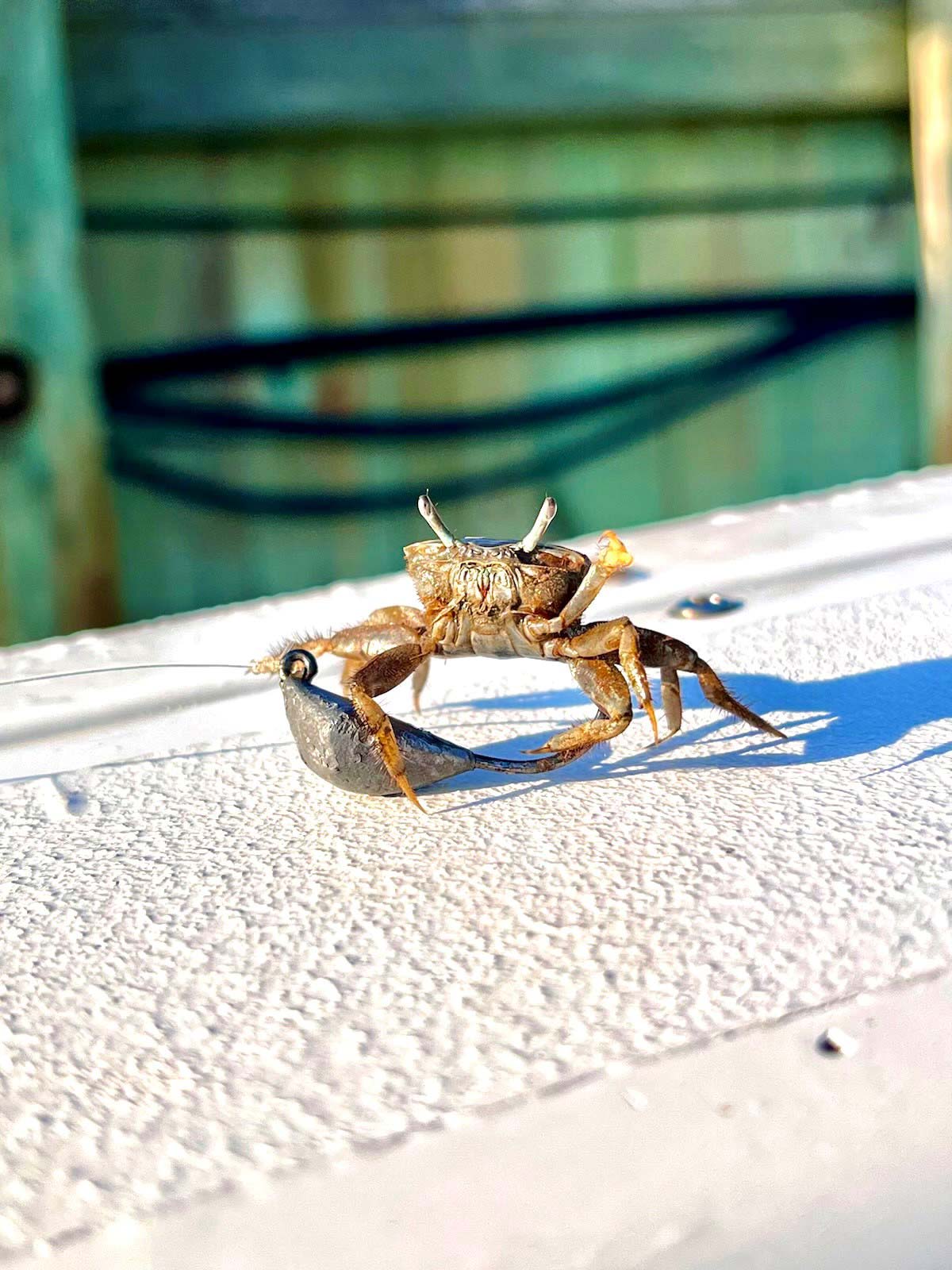
While rocky bottoms and wrecks may yield an occasional sheep among many tog, the easiest place to target sheepshead is on bridges and piers. These woody or metal pilings are covered from the waterline down with barnacles, a sheepshead favorite snack. They also have a slack side to protect them from the current. When the current is ripping, fishing the backsides of these structures is key as sheepshead tend to want to stay out of the current. For this reason, the slack tide is usually the worst for targeting sheepshead as they spread out among the structure. Try to stick to the last two hours of incoming or outgoing for great success.
But besides structure, the most fundamental strategy for catching sheepshead is bait. With chompers that resemble farm sheep – or has some have suggested they’re also quite – a sheepshead’s teeth are instrumental in crunching their favorite food sources: barnacles, crabs, and other mollusks. While the favorite food source for New Jersey sheepshead are barnacles, fishing with barnacles is a bit impractical. Our favorite baits to bet on are fiddler crabs (make sure to rip off the big claw), Asian shore crabs, and sand fleas. All of these are readily available with a little digging around jetties.
For some reason, we’ve found that sheepshead prefer dime-sized crabs and anything bigger may be a waste of time. They always say “elephants eat peanuts” and we believe that when fishing for sheepshead.
Tackle & Techniques
The technique to catch sheepshead is where it is a bit unusual. Since barnacles span from the top of the water column down to the bottom, sheepshead feed throughout the water column. You never know where you are going to find a sheepshead feeding. This has been the biggest advance in sheepshead fishing over the years and we can thank Capt. Dan Schafer for pioneering this technique. The most common technique is to tether a vessel or use a Minn Kota trolling motor to get to an area of interest.
You want to drop your bait as close to the structure or piling as possible in 2- to 3-foot increments, waiting 10 seconds within each increment. Once you reach the bottom, reel up and perform this technique two more times before moving on to another structure. The sheepshead bite typically happens from the top to the middle of the column and it is even more subtle than the usual tog bite. Watch the rod tip or line as the crab descends for any movement at all. They are masters at bait stealing so be prepared to have lots of bait and be ready to set the hook.
Typically, we are using a light 7-foot rod with a strong backbone. Our choice is the Century Weapon Jr. or St Croix Avid inshore paired with a light compact Shimano Stradic in the 2500-3000 series reel. When it comes to braided line, it is more a preference to the specific angler but we tend to lean towards 15- to 20-pound line because of the diameter to cut through the water column and have less resistance in the current. Follow the main line with a 24- to 36-inch section of 20-pound fluorocarbon leader.
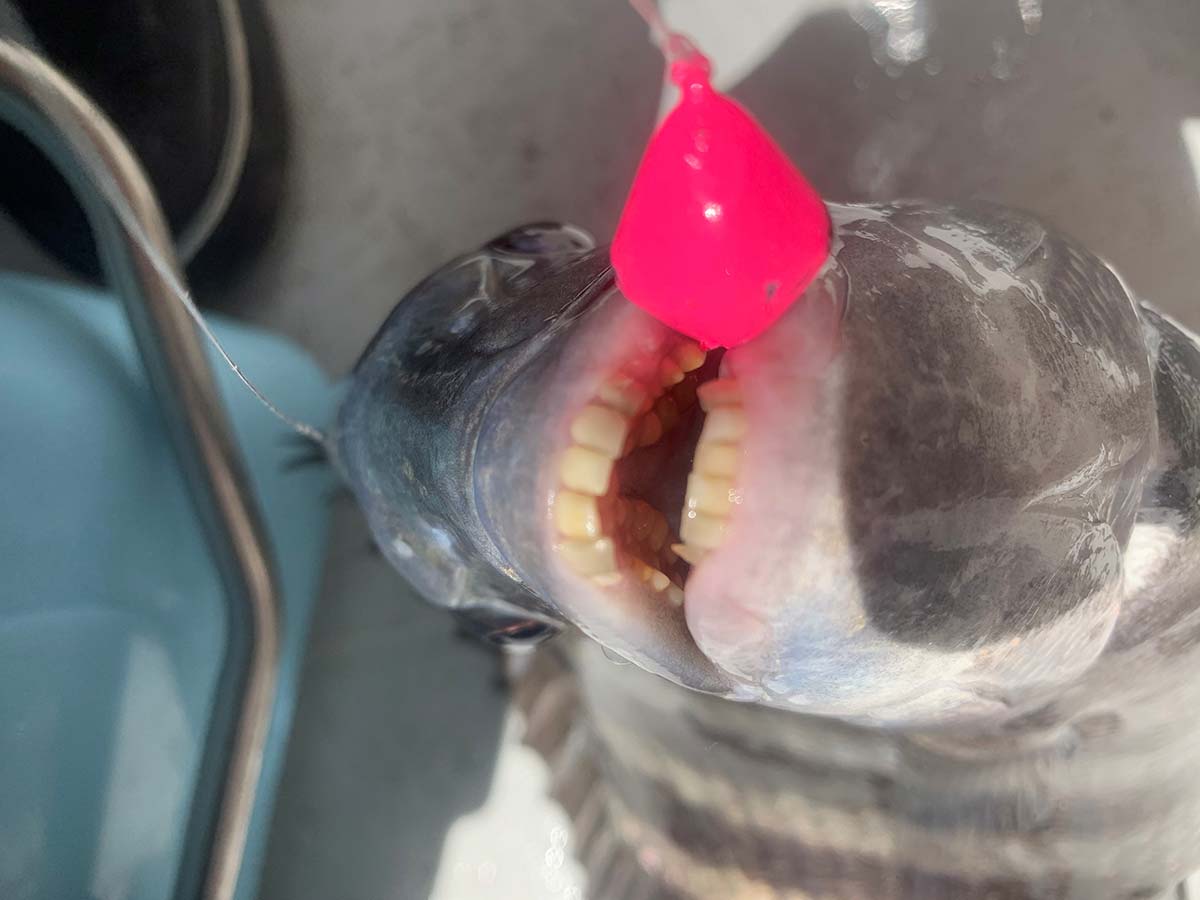
Last but not least is the jig. There are so many types of jigs out in the market to choose from but the Bottom Sweeper jigs created by the sheepshead shepherd himself, Capt. Dan Schafer, are the jigs we would recommend. These jigs are balanced perfectly for the type of vertical jigging that is involved when hunting for sheepshead. Most common jig sizes are anywhere from a quarter- to half-ounce in size.
Looking back at history, there is no denying the fact that sheepshead were and still are admired for their fine white flesh and pleasant taste. But as quickly as they have shown up in our waters, we are already seeing a striking decrease in fish numbers believe it or not. A few years ago, 10 to 25 fish days were a common occurrence, where now catching one or two fish in one day is considered a good day.
At this time, neither New Jersey nor Delaware have size or bag limit regulations for sheepshead. And as popularity has grown for targeting these creatures, it is only reasonable that we are seeing more anglers targeting them and more anglers keeping them. I know most anglers have heard this but if we want a fishery to persist, keeping every fish that comes over the rail isn’t a sustainable option or practice.
Recently, the New Jersey Division of Fish and Wildlife recognized the growing popularity of sheepshead during a recent Marine Fisheries Council meeting. Acknowledging the problem is a good first step in the right direction. Everyone has a right to harvest fish – and we would never tell you otherwise – but selective harvesting is key if we want to keep this population around. While regulators try to figure out how to best protect this “exotic” species, as our good friend Nick Honachefsky would say, it is up to us anglers to be mindful not to overharvest, so as to grow the local population of sheepshead for many seasons to come.



